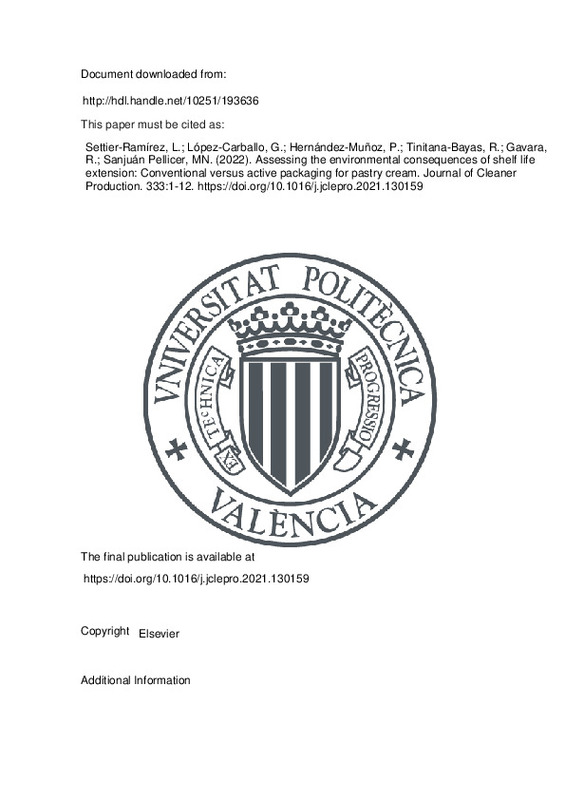JavaScript is disabled for your browser. Some features of this site may not work without it.
Buscar en RiuNet
Listar
Mi cuenta
Estadísticas
Ayuda RiuNet
Admin. UPV
Assessing the environmental consequences of shelf life extension: Conventional versus active packaging for pastry cream
Mostrar el registro sencillo del ítem
Ficheros en el ítem
| dc.contributor.author | Settier-Ramírez, Laura
|
es_ES |
| dc.contributor.author | López-Carballo, Gracia
|
es_ES |
| dc.contributor.author | Hernández-Muñoz, Pilar
|
es_ES |
| dc.contributor.author | Tinitana-Bayas, Raisa
|
es_ES |
| dc.contributor.author | Gavara, Rafael
|
es_ES |
| dc.contributor.author | Sanjuán Pellicer, María Nieves
|
es_ES |
| dc.date.accessioned | 2023-05-26T18:01:53Z | |
| dc.date.available | 2023-05-26T18:01:53Z | |
| dc.date.issued | 2022-01-20 | es_ES |
| dc.identifier.issn | 0959-6526 | es_ES |
| dc.identifier.uri | http://hdl.handle.net/10251/193636 | |
| dc.description.abstract | [EN] Shelf life extension can reduce food losses throughout the entire food chain and packaging can be an effective way to attain this goal. Along these lines, active packaging is an appealing alternative that uses natural antimicrobial compounds to inhibit the growth of microorganisms causing food spoilage. Specifically, a packaging was developed based on polyethylene film with a coating fully compatible with food (all components declared as food additive and food contact materials). This bag is monomaterial, which means that, after use, it can be considered fully recyclable. In this study, conventional and bioactive bags carrying viable Lactococcus lactis subsp. lactis and phytic acid with antimicrobial activity were used to pack pastry cream. The environmental implications of the packaging choice have been assessed applying life cycle assessment to both the empty packages and the complete food-packaging system. To assess the empty packages, a bag of 200 mL capacity was the functional unit, and all life cycle stages were included, from cradle to waste treatment. In that case, the active packaging implies an increase in all the impact categories, due to the application of the bacterial coating on the conventional bag film. When assessing the food-packaging systems, the functional unit was 218 g of packed pastry cream and the system boundaries included the whole life cycle of the pastry cream-package, considering also indirect effects in terms of shelf life and food waste. Under this perspective, the environmental load of the coating production is offset by the extension of product shelf life from 3 to 13 days, with the subsequent reduction in the waste generated along the food chain. In this way, a reduction in all the impact categories corresponding to the pastry cream in active packaging is observed, ranging from 45% for ionizing radiation to 75% for climate change. It can be concluded that, despite the limitations regarding waste estimation, extending the shelf life of foods is a key issue when assessing the environmental impacts of novel packages. Future research should focus on developing better models, based on empirical data, which relate product shelf life and potential waste. In addition, a holistic sustainability assessment should also consider economic issues under a life cycle approach. | es_ES |
| dc.description.sponsorship | The authors acknowledge the financial support of the Spanish Ministry of Science and Innovation (Grant AGL2015-64595-R funded by MCIN/AEI/10.13039/501100011033 and by ERDF A way of making Europe) and of CSIC (201970E084). P. H-M and RG are members of the Interdisciplinary Platform for Sustainable Plastics towards a Circular Economy (SusPlast) from the Spanish National Research Council (CSIC). | es_ES |
| dc.language | Inglés | es_ES |
| dc.publisher | Elsevier | es_ES |
| dc.relation.ispartof | Journal of Cleaner Production | es_ES |
| dc.rights | Reconocimiento - No comercial - Sin obra derivada (by-nc-nd) | es_ES |
| dc.subject | Antimicrobial active packaging | es_ES |
| dc.subject | Food waste | es_ES |
| dc.subject | LCA | es_ES |
| dc.subject | Shelf life | es_ES |
| dc.subject.classification | TECNOLOGIA DE ALIMENTOS | es_ES |
| dc.title | Assessing the environmental consequences of shelf life extension: Conventional versus active packaging for pastry cream | es_ES |
| dc.type | Artículo | es_ES |
| dc.identifier.doi | 10.1016/j.jclepro.2021.130159 | es_ES |
| dc.relation.projectID | info:eu-repo/grantAgreement/MINECO//AGL2015-64595-R/ES/ENVASES PARA ALIMENTOS BASADOS EN MATERIALES ANTIMICROBIANOS AVANZADOS: POLIMEROS DINAMICOS, AUTOHIGIENIZANTES Y "VIVOS"/ | es_ES |
| dc.relation.projectID | info:eu-repo/grantAgreement/CSIC//201970E084/ | es_ES |
| dc.rights.accessRights | Abierto | es_ES |
| dc.contributor.affiliation | Universitat Politècnica de València. Escuela Técnica Superior de Ingeniería Agronómica y del Medio Natural - Escola Tècnica Superior d'Enginyeria Agronòmica i del Medi Natural | es_ES |
| dc.description.bibliographicCitation | Settier-Ramírez, L.; López-Carballo, G.; Hernández-Muñoz, P.; Tinitana-Bayas, R.; Gavara, R.; Sanjuán Pellicer, MN. (2022). Assessing the environmental consequences of shelf life extension: Conventional versus active packaging for pastry cream. Journal of Cleaner Production. 333:1-12. https://doi.org/10.1016/j.jclepro.2021.130159 | es_ES |
| dc.description.accrualMethod | S | es_ES |
| dc.relation.publisherversion | https://doi.org/10.1016/j.jclepro.2021.130159 | es_ES |
| dc.description.upvformatpinicio | 1 | es_ES |
| dc.description.upvformatpfin | 12 | es_ES |
| dc.type.version | info:eu-repo/semantics/publishedVersion | es_ES |
| dc.description.volume | 333 | es_ES |
| dc.relation.pasarela | S\462571 | es_ES |
| dc.contributor.funder | European Regional Development Fund | es_ES |
| dc.contributor.funder | Ministerio de Economía y Competitividad | es_ES |
| dc.contributor.funder | Consejo Superior de Investigaciones Científicas | es_ES |
| dc.subject.ods | 12.- Garantizar las pautas de consumo y de producción sostenibles | es_ES |







![[Cerrado]](/themes/UPV/images/candado.png)

